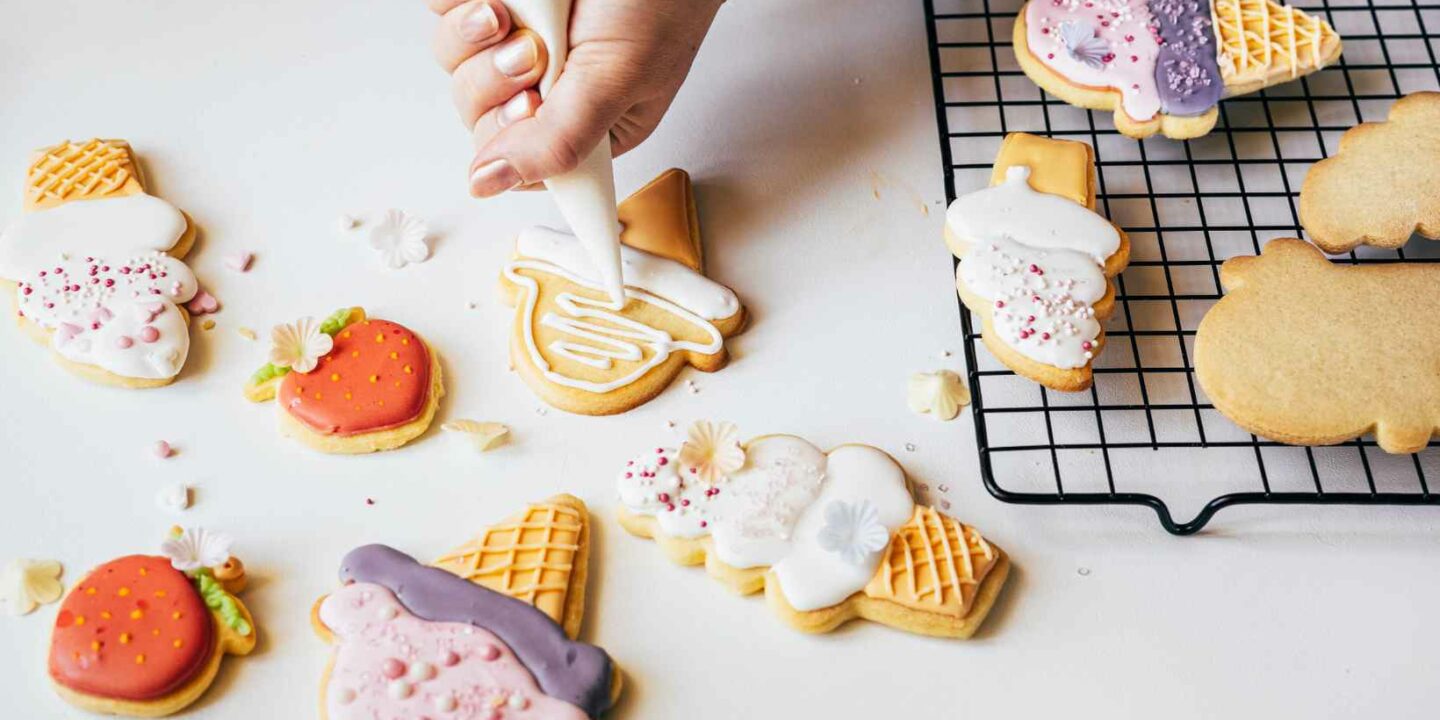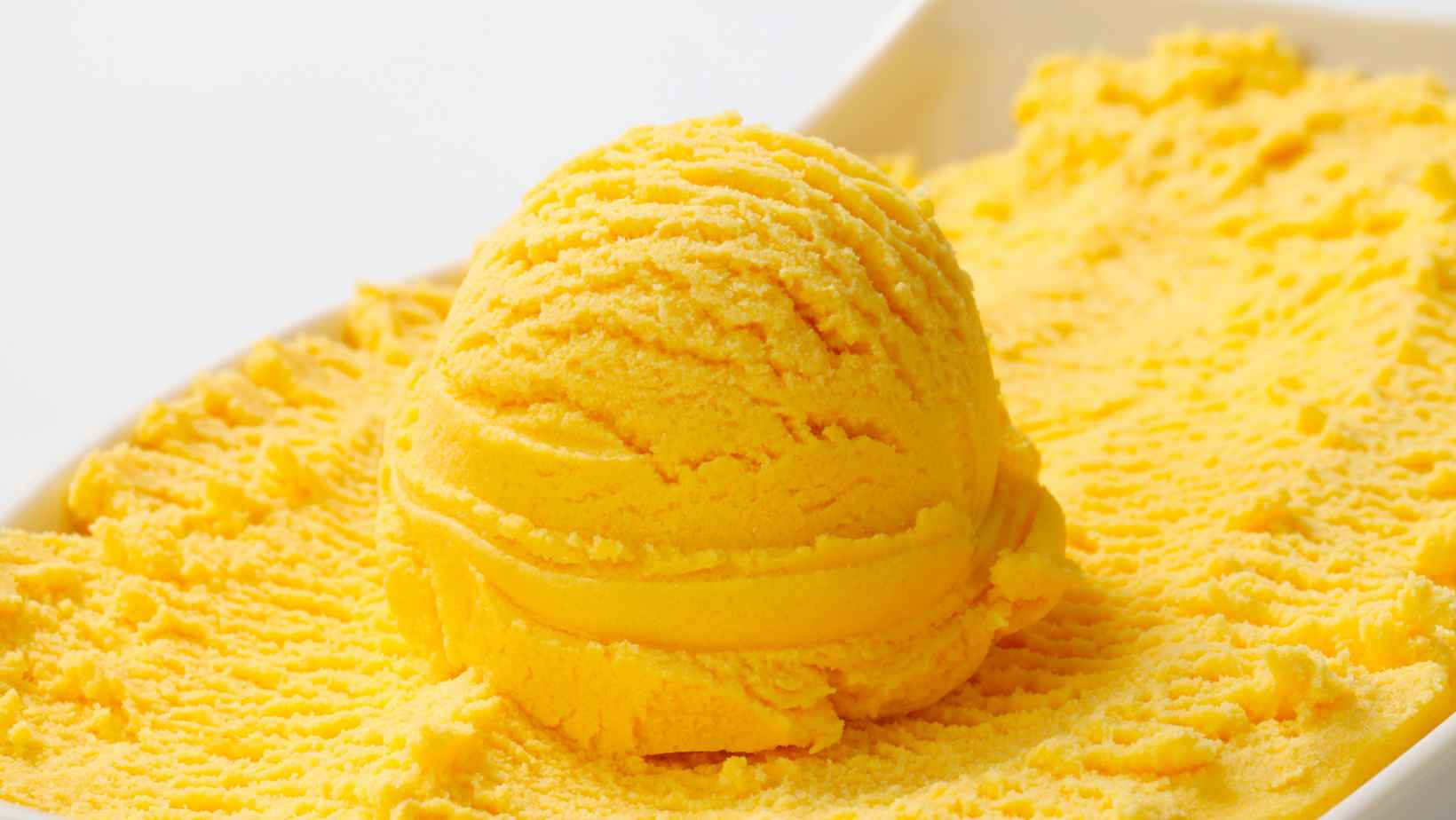
How To Shape Ice Cream Into Balls
To perfect the art of shaping ice cream into balls, you need to know the basics. In order to achieve the perfect scoop, you need to choose the right ice cream, soften it to the right consistency, and prepare the tools and style for shaping. These sub-sections will provide you with the perfect solution for shaping ice cream into perfectly round balls.
Choosing the Right Ice Cream
When it comes to crafting perfectly shaped ice cream balls, the type of ice cream you choose can make all the difference. Here are three points to consider when selecting your ideal ice cream:
- Texture: Choose an ice cream with a smooth and creamy texture that will hold its shape well.
- Flavor: Select a flavor that complements any toppings or mix-ins you plan to use.
- Consistency: Avoid ice creams that are too hard or too soft, as they may be difficult to scoop and shape.
To ensure the best outcome, it’s also essential to let your ice cream soften slightly before shaping. This allows it to become more pliable and easier to mold into the desired shape without losing its texture.
In addition, using high-quality ingredients can make a significant impact on both flavor and consistency. Opting for natural and organic options over imitation flavors and artificial additives can elevate your frozen treats for a more satisfying experience.
A culinary student was once tasked with creating 50 perfectly shaped ice cream balls for a catering event. After hours of struggling with lumpy, uneven scoops, they were reminded of the importance of allowing their ice cream to soften before attempting shaping. With a little bit of patience and practice, they were able to create beautifully formed balls that wowed guests at the event.
Softening ice cream is a lot like softening a heart, except with less emotional baggage and more scooping.
Softening the Ice Cream
Ice cream requires proper softening before shaping to get the desired consistency. Softened ice cream is easy to handle and shape into small balls.
To effectively soften the ice cream, follow these simple steps:
- Remove the ice cream from the freezer and let it sit at room temperature for about 10-15 minutes.
- Afterward, use a spoon or ice cream scoop to stir the ice cream gently until it forms an even texture.
- If it’s still too firm, place it back in the freezer for another 5-10 minutes and repeat the process until you obtain a smooth consistency.
- Now you can finally start rolling your desired size of ice cream balls!
Remember that once softened, and shaped into balls, move them onto a baking tray lined with parchment paper and put them back in the freezer for at least 30 minutes before serving.
Avoid applying heat or microwaving to speed up the softening process as this could lead to melted portions affecting its flavor. Furthermore, using a melon baller should be avoided as it creates inconsistent measurements.
Fun facts – Did you know? The record for creating the tallest stack of scoops belongs to Italian Dimitri Panciera, who stacked 125 scoops on top of each other in 2015.
Get ready to scoop your way into ice cream ball mastery, but first, let’s make sure your tools are as sharp as your wit.
Preparing the Tools and Style
To shape perfect ice cream balls, it’s vital to start with the right tools and style. Here’s how you can prepare them:
- Choose a sturdy ice cream scoop that won’t bend, as this will make it easier to shape consistent balls.
- Dip the scoop into warm water before each use, to prevent the ice cream from sticking.
- Decide on the style of your ice cream balls – classic or modern. Classic involves using a single scoop for each ball while modern employs shaping two or more scoops together.
- Ensure that your hands are clean and dry before handling the ice cream to prevent melting.
- Have a sheet pan lined with parchment paper ready so you can place your prepared ice cream balls.
- If possible, put your prepared sheet pan in the freezer for 10 minutes before serving.
It is important to note that over-scooping may cause cracks in your ice cream ball surface, which can melt or lose their shape during transportation.
When plating scooped-out portions on a cone or cup, consider adding toppings such as sprinkles or hot fudge sauce for a finishing touch.
A study conducted by Gelato inventor Francesco Procopio dei Coltelli from Sicily claims he invented gelato during in 1686.
Get ready to roll, scoop and shape your way to ice cream perfection with these pro techniques for balling up your favorite frozen treat.
Techniques for Shaping Ice Cream Balls
To master the skill of shaping perfect ice cream balls, you need to know the right techniques. In order to achieve this, we will familiarize you with three different methods: using a scoop, using a spoon, and using your hands. Each of these techniques has its own unique benefits, so keep reading to find out how to shape your ice cream like a pro.
Using a Scoop
A Professional Explanation for Molding Ice Cream Balls with a Scoop
To shape ice cream balls like a pro, using a scoop is an efficient and precise technique. It guarantees identically sized portions that look aesthetically pleasing and are easy to serve. Here’s how you can use a scoop to mold perfectly formed ice cream balls.
- Chill the Scoop: Before starting, make sure you chill the ice cream scoop in a bowl of cold water or place it in the freezer for a few minutes.
- Position the Scoop: Hold the scoop vertically above the carton of ice cream, positioning it on top of your preferred portion size.
- Apply Pressure: Use firm pressure to scoop out the desired amount of ice cream while ensuring that you don’t break through to the bottom of the carton.
- Release and Frame: Quickly swipe across the top edge of the carton with an offset spatula to remove any excess ice cream from around the ball, ensuring that it has precise edges.
- Transfer and Serve: Turn over and release onto plates or bowls gently, placing them directly into small cups or flat-bottom cones as per preference.
Additionally, this technique works well when sculpting ice-cream rolls which provide added elegance and texture to various desserts. It’s essential to use tools designed for making rolled scoops specifically. The key is to keep everything as cold as possible so that scooping is effortless and quick without causing melting.
Legend has it that in 1907, an Italian immigrant named Italo Marchiony invented an ice cream cone mold with tin alloy sheets instead of traditional glassware cups but struggled with molding consistent scoops by hand until he decided to modify his wife’s pastry tool called Spadingola della Pasticciera (Pastry Spade). Marchiony etched shallow grooves across its surface’s round tip, creating what became popularly known as the “scoop.” This modification technique has been used in every modern-day scoop ever since.
Who needs an ice cream scooper when you can just use a spoon and call it ‘rustic’?

Using a Spoon
When employing an eating utensil for shaping ice cream balls, a Spoon is a popular choice. Spoon technique is not only simple but also the most commonly used method for shaping ice cream balls all over the world.
Here’s how to shape ice cream balls using a spoon in four easy steps:
- Take out the ice cream from the freezer and let it sit for 5-7 minutes until it softens.
- Use a warmed or heated spoon and scoop a ball of softened ice cream from the carton.
- Place the serving scoop into very hot water to warm up if needed during scooping.
- Gently, shape the ball with your spoon and place it on your serving dish
It is essential to ensure that your spoon stays clean throughout scooping, especially when dealing with different flavors of ice cream. By cleaning your spoon between each scoop, you’ll avoid unnecessary mixing of colors and flavors.
One important detail to keep in mind while shaping ice cream balls using a spoon is always to remove any hard lumps that develop when freezing overnight using additional utensils before tackling them with your serving scoop.
The practice of sculpting ice cream balls has been around for years, spanning back many generations. In ancient times people used their hands as this was before modern utensils were invented that could be used for carving or shaping objects from food like matching shapes of wooden blocks.
Who needs a fancy ice cream scoop when you have perfectly good hands to create wonky, misshapen balls?
Using Your Hands
One effective approach to shape ice cream balls is by utilizing manual dexterity. Hands are ideal tools for creating a precise and uniform roundness. Using a light touch, gently scoop the required amount of ice cream from the container. Cupping your hands around the ice cream ball, rotate it in between your palms until you achieve a nice round shape.
It’s crucial not to squeeze or press too hard while shaping the ice cream ball, as this causes melting and unnecessary deformations. Instead, ensure that your hands are clean, cool and have enough space for maneuvering during the shaping process.
To stabilize the ice cream ball, some experts recommend placing it in cold water before handling it with your hands. This method ensures that the ice doesn’t stick to your fingers, making it much easier to mold.
Overall, Employing these hand-shaping techniques can produce visually appealing and delicious servings of ice cream.
Did you know that Ice-cream scoops date as far back as ancient Persia? It was developed using simple metal rods used to remove excess water from wet clothes called “chaluts” to scoop out frozen sweets made of vermicelli, fruits juices and rosewater known as “faloodeh.” Many years later, this innovation led to other unique dessert presentation methods currently being employed worldwide.
Get ready to scoop like a pro with these ball-istic tips and tricks for ice cream shaping.
Tips and Tricks for Shaping Ice Cream Balls
To master the art of shaping ice cream into perfect balls, utilize these tips and tricks. With the ‘Using a Cold Surface’, ‘Using a Wet Scoop or Spoon’, and ‘Using Different Flavors and Mix-ins’ methods, you can achieve the ideal shape and texture for your ice cream balls.
Using a Cold Surface
When working with ice cream, utilizing a chilled surface can be quite helpful. Here’s how you can use a cold surface to shape ice cream balls:
- Begin by preparing your surface. It could be a countertop or baking sheet that you place in the freezer for about 15 minutes.
- Once your surface is adequately chilled, take it out and scoop the ice cream onto it.
- Use an ice cream scoop to create portioned balls of ice cream directly onto the cold surface.
- Afterward, use a spatula to slide beneath each of the ice cream scoops and carefully lift them off of the surface.
- Transfer each scoop into individual cups or bowls before serving.
It is essential to ensure that your surface remains cold throughout the process to prevent melting and stickiness.
For best results, try using different shapes and sizes of scoops on the ice cream, creating a variety of ball sizes for visual interest.
Interestingly enough, it was reputed that in ancient times, royalty would have servants harvest snow from mountaintops during the winter months and keep them safe in underground chambers that utilized ventilation shafts for cooling during summer months. They would then use this snow as their source of “ice”, mixing it with fruit juices and occasionally honey or wine. The process evolved over time into what we now know today as sorbet or sherbet!
Don’t worry about using a wet scoop or spoon, it’s just the ice cream’s way of getting a little steamy.
Using a Wet Scoop or Spoon
One way to shape ice cream balls is to use a scoop or spoon that has been wet. This helps the ice cream release easily and minimizes any sticking or clumping. Here are some tips on using a wet scoop or spoon:
- Dip the scoop or spoon in warm water before each use
- Shake off excess water before scooping
- Scoop quickly to prevent melting
- Wipe the scoop or spoon between servings
To achieve perfectly shaped ice cream balls, it’s important to consistently use a wet scoop or spoon. While this method may require more cleaning, the result is worth it for presentation purposes.
When using a wet scoop or spoon, be sure to choose one that is appropriately sized for your container and desired portion size. A large scoop can make it difficult to remove individual portions from small containers, while a small scoop may take too long to serve multiple people.
In my experience working in an ice cream shop, I once witnessed a customer struggling with forming their own ice cream ball at home because they didn’t know about using a wet scoop. After sharing this tip with them, they were much happier with the results of their homemade dessert.
Add some mix-ins to your ice cream and suddenly it becomes a gourmet dessert, instead of just something you eat straight out of the carton at 2am.
Using Different Flavors and Mix-ins
Mixing Things Up: Unleashing the Power of Various Flavors and Add-ins
Combining different flavors and add-ins can create a unique and memorable ice cream experience. Here are five ways to do it:
- Incorporate fresh fruit like strawberries or blueberries into your ice cream base
- Mix in your favorite candy, chopped nuts, or cookie pieces for added texture
- Try incorporating unique ingredients such as lavender, basil, or honeycomb for added flavors
- Create a swirl effect by drizzling in fudge or caramel syrup
- Experiment with flavor extracts to achieve new combinations such as hazelnut espresso or peppermint patty.
For an extra twirl on classic recipes, try substituting almond milk or coconut milk for dairy.
If you’re looking to elevate your ice cream-making game even further, try experimenting with infused oils like olive oil or coconut oil for added complexity.
Did you know that vanilla is the most popular ice cream flavor worldwide? According to market research firm YouGov in 2020, over one-third of all Americans prefer this classic sweet treat.
Remember, presentation is key – no one wants to eat a lumpy, misshapen ball of ice cream unless it’s intentionally meant to look like that.
Serving and Presenting Ice Cream Balls
To perfect your ice cream presentation skills with various plating techniques, decorating with toppings, and pairing it with other desserts, explore the section “Serving and Presenting Ice Cream Balls” in “The Art Of Shaping Ice Cream Into Balls” article.
Plating Techniques
The art of presenting frozen confections through advanced culinary techniques is a critical aspect of succeeding in the dessert industry. To optimize customer satisfaction, it is essential to feature well-presented and innovative ice creams.
| Plating Techniques Table | ||
| Tools | Methodology | Outcome |
|
|
|
Notably, chefs can form ice creams using molds and cookie cutters, offering eccentric shapes that complement the dessert experience.
Interestingly, the rise of molecular gastronomy brought innovative techniques like liquid nitrogen cooling and freezing used to develop modern serving styles by creating crispy crusts around soft interiors.
Historically, various cultures showcased their distinct plating techniques; Japan’s kinshachi entails intricate carving and three-dimensional sculptures carved from ice cream, while French pâtissiers developed unique canvasses layered with icings augmented by distinct shell patterns outlining each element on display.
Ice cream toppings are like the cherry on top, except they’re more like a whole buffet on top.
Decorating with Toppings
Adding toppings to ice cream enhances the overall look and taste of the dessert. Here are three ways to decorate with toppings:
- Use sprinkles, chocolate chips, nuts or fruit as a topping.
- Create a sundae by layering sauces, whipped cream and additional toppings.
- Use crushed cookies or candy bars as a base before adding scoops of ice cream.
When deciding on toppings, consider flavor combinations and textures that will complement the ice cream flavor. For instance, chocolate sauce may pair well with vanilla ice cream, while berries can bring out the best in strawberry-flavored ice cream.
To create an even more visually appealing dessert, vary the size and shape of toppings for added interest.
During my time working at an ice cream shop, I once witnessed a customer creating their own topping masterpiece- starting with scoops of caramel and vanilla ice cream followed by layers of hot fudge, caramel sauce and salted peanuts. The finished product was a true work of art that tasted just as good as it looked.
You can’t go wrong pairing ice cream balls with any dessert, unless it’s just another bowl of ice cream balls – then you might want to reconsider your life choices.
Pairing with Other Desserts
When it comes to pairing ice cream balls with other desserts, there are numerous options available. Here are three popular pairings that you can try:
- Ice Cream and Pie – Pair your ice cream ball with a slice of freshly baked pie for an irresistible combination. Some popular pie flavors to pair with include apple, pumpkin, and pecan.
- Ice Cream and Brownies – Combine your ice cream ball with a warm brownie for an indulgent dessert experience. You can also add toppings such as caramel sauce or whipped cream for added flavor.
- Ice Cream and Cookies – Place your ice cream ball between two freshly baked cookies of your choice for a delightful sandwich dessert. You can roll the edges in sprinkles or crushed nuts to give them an extra crunch.
If you’re looking to take things up a notch, you can get creative with your pairings by experimenting with different flavors and textures. For example, try pairing a fruity sorbet with a slice of angel food cake or adding a scoop of mint chip ice cream to a cupcake.
To make the most out of these pairings, it’s important to choose complementary flavors that will enhance the taste of both desserts. Consider the texture of each dessert as well; combining crunchy with creamy can create a satisfying contrast.
Don’t be a square, shape your ice cream balls with care!
Common Mistakes to Avoid When Shaping Ice Cream Balls
To avoid common mistakes when shaping ice cream balls, learn how to handle ice cream gently, use correct tools, and remember to rest your scoop or spoon in hot water. These small habits can save you from frustration and imperfect ice cream spheres.
Handling Ice Cream too Roughly
When molding ice cream spheres, refraining from handling the product too roughly is critical. Limiting pressure when forming each ball maintains the dessert’s structure and texture. Overhandling or squeezing may cause melting, which can result in an unappealing presentation. Consequently, a gentle touch is required to achieve perfectly shaped cones or balls.
It is essential to utilize scoops that accurately match the holder size of serving vessels when molding ice cream balls. Typically, many mistakes are avoided during preparation with molds that resemble ice cream cups; this enables one to focus on getting the correct amount of product in each container. Using smaller vessels than required results in insufficient quantities that appear unprofessional.
To guarantee successful frozen treat formation, consider producing consistent scoops from one vessel. By utilizing a 3-ounce scoop and ensuring even-distribution throughout multiple containers, ice cream balls can be molded swiftly and effectively without errors or messy servings.
A common culinary myth states Napoleon Bonaparte inspired the custom of molten individuals needing their ice cream rounded off with a sharp spoon edge as he was adamant that he preferred his crockery pieces not being used for such tasks due to hygiene concerns. However, it remains unclear whether this tale factually occurred or not.
Using a fork to shape your ice cream balls is like using a spoon to fix your car engine – it’s just not the right tool for the job.
Using the Wrong Tools or Equipment
When it comes to Ice Cream Ball shaping, using the right tools and equipment can make a big difference. Here are six points to consider:
- Using a spoon with sharp edges can damage the texture of the ice cream
- Using warm or hot scoops can thaw the ice cream too quickly, leading to an unpleasant consistency
- Using plastic molds instead of metal can create uneven melting due to varying conductivity
- Using a jagged ice cream scoop or one that is too small will ruin the ball shape
- Using a utensil that is not deep enough will also lead to irregular shapes
- Not measuring consistent portions can result in different sized balls, causing disharmony in presentation.
It’s important to note that there may be other unique details regarding proper tools and equipment that are specific to certain types of ice cream, such as gelato or sorbet.
According to Food & Wine Magazine, “professional pastry chefs use something called a ‘disher’ which is like an ice cream scoop on steroids, typically made from stainless steel with interchangeable parts for different portion sizes.” If you forget to rest your scoop or spoon in hot water, your ice cream might end up looking like a block of Swiss cheese – and not in a good way.
Forgetting to Rest Scoop or Spoon in Hot Water
To ensure perfectly shaped ice cream balls, it is crucial not to neglect the act of resting your scoop or spoon in hot water. This process helps maintain smooth scooping and prevents the ice cream from sticking to the scooper or spoon.
Here is a 6-step guide to help you implement this step:
- Fill a bowl with hot water.
- Dip your scooper or spoon into the hot water, completely submerging it for a few seconds.
- Shake off any excess water gently.
- Scoop or spoon out your desired amount of ice cream smoothly.
- Repeat steps 2-4 as necessary, keeping in mind that you may need to reheat and rinse your utensil periodically.
- Enjoy the perfectly shaped ice cream!
It’s important not to allow the utensil to cool down after dipping it into hot water, as this could cause difficulties in shaping the ice cream properly. Additionally, by resting your scoop or spoon in hot water, you will be able to create clean-cut edges and prevent unsightly marring.
To vary up their desserts, some may want to try shaping their ice cream differently rather than scooping it traditionally. For example, using cookie cutters can be an interesting alternative that could add flair to plated desserts.
When working with flavored varieties of ice creams such as those containing chunks of fruit or other ingredients like cookies dough, pre-freezing them before starting is a wise choice. This action will help keep the mix-ins mixed in place so they don’t clump together while scooping.
